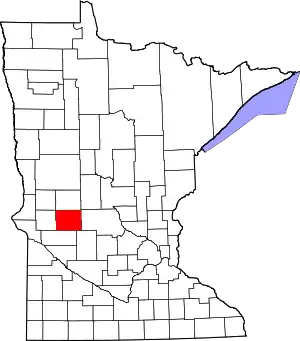Farwell, Minnesota
Farwell is a city in Pope County, Minnesota, United States. The population was 51 at the 2010 census.[6]
Farwell | |
|---|---|
 Location of Farwell, Minnesota | |
| Coordinates: 45°45′7″N 95°37′6″W | |
| Country | United States |
| State | Minnesota |
| County | Pope |
| Area | |
| • Total | 0.26 sq mi (0.66 km2) |
| • Land | 0.26 sq mi (0.66 km2) |
| • Water | 0.00 sq mi (0.00 km2) |
| Elevation | 1,345 ft (410 m) |
| Population | |
| • Total | 51 |
| • Estimate (2019)[3] | 52 |
| • Density | 203.13/sq mi (78.46/km2) |
| Time zone | UTC-6 (Central (CST)) |
| • Summer (DST) | UTC-5 (CDT) |
| Zip code | 56327 |
| Area code(s) | 320 |
| FIPS code | 27-20690[4] |
| GNIS feature ID | 0643575[5] |
History
Farwell was platted in 1887.[7] A post office was established at Farwell in 1887, and remained in operation until 1998.[8]
Geography
According to the United States Census Bureau, the city has a total area of 0.29 square miles (0.75 km2), all land.[9]
Minnesota State Highway 55 serves as a main route in the community.
Demographics
| Historical population | |||
|---|---|---|---|
| Census | Pop. | %± | |
| 1910 | 141 | — | |
| 1920 | 140 | −0.7% | |
| 1930 | 147 | 5.0% | |
| 1940 | 132 | −10.2% | |
| 1950 | 112 | −15.2% | |
| 1960 | 106 | −5.4% | |
| 1970 | 102 | −3.8% | |
| 1980 | 77 | −24.5% | |
| 1990 | 74 | −3.9% | |
| 2000 | 57 | −23.0% | |
| 2010 | 51 | −10.5% | |
| 2019 (est.) | 52 | [3] | 2.0% |
| U.S. Decennial Census[10] | |||
2010 census
As of the census[2] of 2010, there were 51 people, 27 households, and 14 families living in the city. The population density was 175.9 inhabitants per square mile (67.9/km2). There were 30 housing units at an average density of 103.4 per square mile (39.9/km2). The racial makeup of the city was 100.0% White.
There were 27 households, of which 22.2% had children under the age of 18 living with them, 37.0% were married couples living together, 3.7% had a female householder with no husband present, 11.1% had a male householder with no wife present, and 48.1% were non-families. 37.0% of all households were made up of individuals, and 7.4% had someone living alone who was 65 years of age or older. The average household size was 1.89 and the average family size was 2.43.
The median age in the city was 49.5 years. 15.7% of residents were under the age of 18; 0.0% were between the ages of 18 and 24; 29.4% were from 25 to 44; 37.2% were from 45 to 64; and 17.6% were 65 years of age or older. The gender makeup of the city was 47.1% male and 52.9% female.
2000 census
As of the census[4] of 2000, there were 57 people, 27 households, and 16 families living in the city. The population density was 198.3 people per square mile (75.9/km2). There were 30 housing units at an average density of 104.4 per square mile (39.9/km2). The racial makeup of the city was 100.00% White.
There were 27 households, out of which 22.2% had children under the age of 18 living with them, 37.0% were married couples living together, and 40.7% were non-families. 40.7% of all households were made up of individuals, and 22.2% had someone living alone who was 65 years of age or older. The average household size was 2.11 and the average family size was 2.88.
In the city, the population was spread out, with 19.3% under the age of 18, 14.0% from 18 to 24, 19.3% from 25 to 44, 22.8% from 45 to 64, and 24.6% who were 65 years of age or older. The median age was 44 years. For every 100 females, there were 103.6 males. For every 100 females age 18 and over, there were 119.0 males.
The median income for a household in the city was $28,125, and the median income for a family was $31,875. Males had a median income of $28,333 versus $13,750 for females. The per capita income for the city was $19,917. None of the population or the families were below the poverty line.
References
- "2019 U.S. Gazetteer Files". United States Census Bureau. Retrieved July 26, 2020.
- "U.S. Census website". United States Census Bureau. Retrieved 2012-11-13.
- "Population and Housing Unit Estimates". United States Census Bureau. May 24, 2020. Retrieved May 27, 2020.
- "U.S. Census website". United States Census Bureau. Retrieved 2008-01-31.
- "US Board on Geographic Names". United States Geological Survey. 2007-10-25. Retrieved 2008-01-31.
- "2010 Census Redistricting Data (Public Law 94-171) Summary File". American FactFinder. U.S. Census Bureau, 2010 Census. Retrieved 23 April 2011.
- Upham, Warren (1920). Minnesota Geographic Names: Their Origin and Historic Significance. Minnesota Historical Society. p. 431.
- "Pope County". Jim Forte Postal History. Archived from the original on 5 March 2016. Retrieved 1 August 2015.
- "US Gazetteer files 2010". United States Census Bureau. Archived from the original on 2012-01-25. Retrieved 2012-11-13.
- "Census of Population and Housing". Census.gov. Retrieved June 4, 2015.
